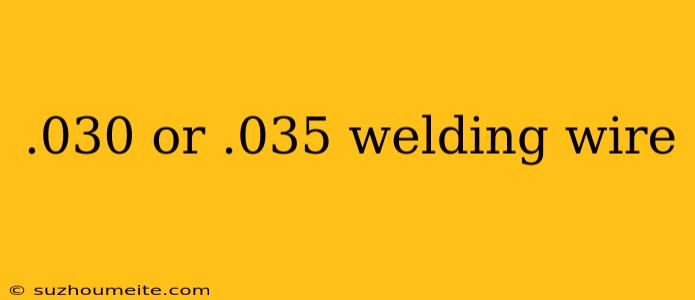.030 or .035 Welding Wire: Which One to Choose?
When it comes to welding, choosing the right welding wire is crucial for achieving strong and reliable welds. Two of the most common welding wire sizes used in MIG (GMAW) welding are .030 and .035 inches in diameter. Both sizes have their own advantages and disadvantages, and the choice between them depends on several factors, including the type of project, metal thickness, and welding technique.
What's the difference between .030 and .035 welding wire?
.030 Welding Wire
- Thinner and more versatile: .030 welding wire is thinner and more flexible, making it ideal for welding thinner materials, such as automotive body panels, aluminum, and stainless steel.
- Easier to feed: The smaller diameter of .030 wire makes it easier to feed through the welding gun, reducing the risk of wire feed problems.
- Less heat input: .030 wire requires less heat input, which is beneficial when welding thinner materials that can be prone to burn-through.
.035 Welding Wire
- Thicker and more durable: .035 welding wire is thicker and more durable, making it better suited for welding thicker materials, such as heavy equipment, farm equipment, and construction equipment.
- More heat input: The larger diameter of .035 wire requires more heat input, which is beneficial when welding thicker materials that require more penetration.
- Better for out-of-position welding: .035 wire is better suited for out-of-position welding, such as overhead or vertical welding, due to its increased durability and resistance to wire feeding issues.
When to use .030 welding wire
- Welding thinner materials: .030 wire is ideal for welding materials with a thickness of 1/8 inch or less.
- Welding aluminum or stainless steel: .030 wire is a good choice when welding aluminum or stainless steel due to its lower heat input and reduced risk of burn-through.
- Welding in tight spaces: The thinner diameter of .030 wire makes it easier to weld in tight spaces or corners.
When to use .035 welding wire
- Welding thicker materials: .035 wire is better suited for welding materials with a thickness of 1/8 inch or more.
- Welding heavy equipment: .035 wire is a good choice when welding heavy equipment, farm equipment, or construction equipment due to its increased durability and heat input.
- Out-of-position welding: .035 wire is better suited for out-of-position welding, such as overhead or vertical welding.
Conclusion
In conclusion, the choice between .030 and .035 welding wire depends on the specific requirements of your project. If you're welding thinner materials, aluminum, or stainless steel, .030 wire is a good choice. However, if you're welding thicker materials, heavy equipment, or require more heat input, .035 wire is the better option. Understanding the differences between these two wire sizes will help you achieve stronger, more reliable welds and improve your overall welding performance.
